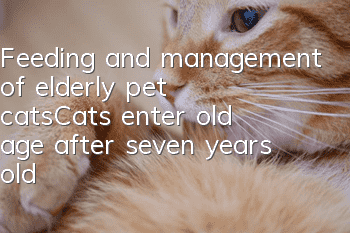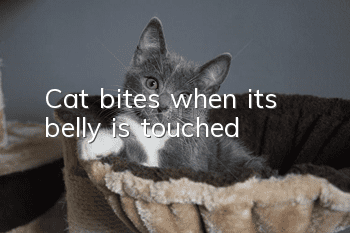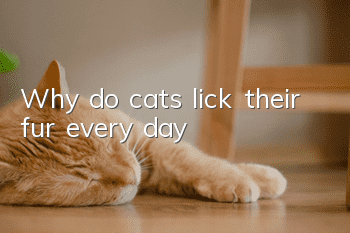Feeding and management of elderly pet cats_Cats enter old age after seven years old

Cat aging is a slow and inevitable process. Aging is a physiological process in which metabolism is disrupted at the molecular and cellular levels over time. Eventually, this will lead to physical deterioration and death. Of course, cat aging is not only physical, but also has psychological changes, which will affect the cat’s sleep and other quality of life. Therefore, all aspects of cat geriatric health care management are crucial.
1. Feeding and management of elderly cats
The life span of cats is similar to that of dogs, and the average age is also about ten years. For pet cats, when they turn 7 years old, it means that they have begun to enter old age. Cats' bodies will slowly age in the future, and their body functions will slowly decline. Therefore, special attention should be paid when feeding elderly cats. Especially in terms of diet, as an owner, you need to know what is better for elderly cats to eat.
But high-quality, easily digestible protein is more important than ever to maintain overall good health. High-quality senior cat food concentrates a variety of nutrients. It is of high quality, low in fat content, protein and easily digestible carbohydrates to provide the energy needed by senior cats.
Important minerals help enhance the health of bones and joints, and vitamins and proteins help strengthen the immune system and prevent the occurrence of infectious diseases. Senior cat food has a special formula for senior cats, adapting to and meeting the nutritional needs and eating habits of senior cats. Therefore, cats can eat a large meal without worrying about any nutritional deficiencies.
2. Medical care
1. Digestive tract
Dental disease may affect food intake, and older cats may also have reduced digestibility of protein, fat, and starch. Providing a diet suitable for older or older healthy cats can significantly improve their quality of life and slow the aging process. Vitamin E improves fat digestibility, and vitamin B12 has also been shown to aid protein and fat digestion. The benefits of better providing antioxidants, essential fatty acids and prebiotics throughout the cat’s life cycle are also now well recognized.
2. Coat
In addition to age-related diseases such as chronic kidney disease or hyperthyroidism that may cause changes in the skin and coat, osteoarthritis may also impair a cat's grooming ability, resulting in a messy appearance. In older cats, there may be symptoms such as white hair, hair loss, nail deformity, and brittle nails. In addition, older cats' skin gradually loses elasticity, and there may be changes in the sebaceous glands and arrector pili muscles.
3. Urinary tract
Older cats are at increased risk for urinary tract infections due to their reduced ability to concentrate urine, not to mention the possibility of other medical conditions such as chronic kidney disease and diabetes. Calcium oxalateStones are mostly seen in middle-aged to older cats. Chronic kidney disease is the leading cause of death in cats. Early diagnosis and treatment through screening exams is the best way to prolong the survival of affected cats. Proper dietary modification has been shown to be the best way to treat chronic kidney disease in cats. For cats with anorexia, feeding tubes (esophagostomy) can be used long-term.
4. Endocrine system
Diabetes is one of the most common endocrine diseases in cats. It is associated with obesity, and 85%-95% of cases are type II. The condition may be relieved by giving a proper diet. Hyperthyroidism appears to be on the rise in cats, and diagnosis is based on a combination of clinical symptoms and elevated T4 values. Hyperadrenalism in cats is less common than in dogs and is usually pituitary-dependent but may also be iatrogenic (steroid drugs). Hypoadrenocorticism is a rare autoimmune disease and hyperaldosteronism in cats is often caused by tumors.
5. Cancer
Like all other species, the incidence of tumors in cats increases with age (immune aging). Environmental factors, such as white cats' exposure to sunlight, passive smoking, etc., play an important role in certain tumors (such as squamous cell carcinoma). Guidelines to limit the risk of vaccine-induced fibrosarcoma are now in place. Fortunately, recent major research advances in the diagnosis and treatment of tumors, as well as better pain-awareness management methods, mean that cats with cancer can expect to live longer, more comfortable lives.
3. Quality of life
Older cats will suffer from hearing loss, and some cats will gradually lose their hearing. The fur appears thin and dry, hair loss is severe, the body becomes weak, muscles atrophy, and the fluid between joints begins to dry up, causing inflammation and discomfort. The lens of the eye becomes cloudy and slightly gray-blue. The fur around the mouth, nose, and ears turns white or yellow. Attention should be paid to regular care of elderly cats and improved living conditions.
In routine diagnosis, it is very important to regularly assess the cat's quality of life. Some owners may overlook important signs of pain in their cats, and it is the job of the clinical veterinarian to ask what the problem is. Cats are masters at hiding discomfort, disease, and pain because showing signs of weakness could prove to be their Achilles heel in their survival in the wild.
Doctors should spend some time talking with owners about how to make life easier for older cats, and they often get creative. In this way, cats with arthritis, for example, may benefit from some changes in their environment, such as slightly elevated food and water bowls, using a litter box with lower rims, and making one that helps the cat pass Cat holes and ensuring ramps to reach his favorite places and more. If necessary, the owner may also move the furniture to make some changes.
- What is the personality of an Abyssinian cat?
- Cat eyebrows are symmetrically bald on both sides
- How to train a cat not to go to bed? How to train a cat not to go to bed!
- How to scientifically raise cats during pregnancy? Will a pregnant woman get infected if she is scratched by a cat?
- How to treat feline seborrheic dermatitis?
- Symptoms and prevention of pica in cats, a must-read for cat owners!
- 6 Signs Your Cat Needs “Deworming”
- What causes ascites in cats? Treatment of nutritional ascites in cats!
- The female cat keeps meowing at her owner after giving birth
- What are the common types of skin diseases in cats?



